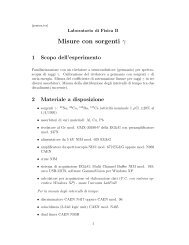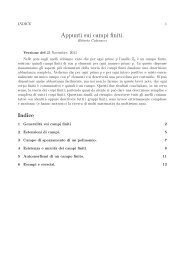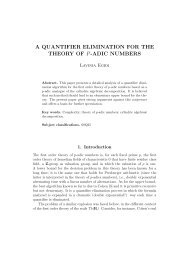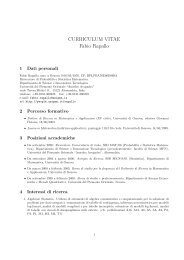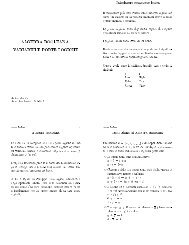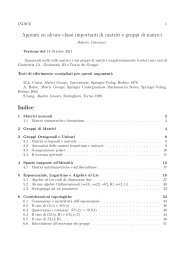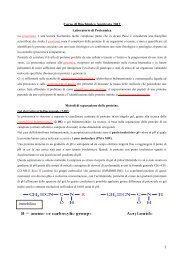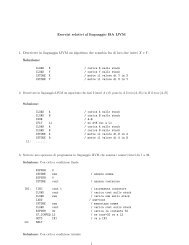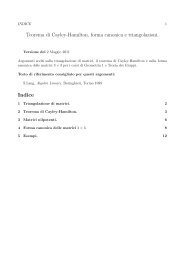Authentication and Access Delegation with User-Released Certificates
Authentication and Access Delegation with User-Released Certificates
Authentication and Access Delegation with User-Released Certificates
You also want an ePaper? Increase the reach of your titles
YUMPU automatically turns print PDFs into web optimized ePapers that Google loves.
in the following. Then, in Section 4 we outline the scheme<br />
based on short-lived certificates. Section 5 describes the<br />
challenge-response variant. The implementation is discussed<br />
in Section 6. We analyze in Section 7 the security of our system.<br />
We conclude <strong>with</strong> some additional remarks <strong>and</strong> future<br />
work.<br />
2. RELATED WORK<br />
Secure access for a mobile user is certainly possible using<br />
specialized hardware (challenge response devices, smartcards,<br />
etc.). But we rule out this possibility since we don’t<br />
want to give costly hardware to our users <strong>and</strong> we want to<br />
enable them to connect to our web-server even from a computer<br />
in an Internet Café. <strong>Authentication</strong> <strong>with</strong> certificates<br />
via a web-server would be fine, except that the certificate<br />
(along <strong>with</strong> the corresponding private key) is bound to remain<br />
in the browser’s database, unless explicitly deleted by<br />
the user. But, as we said, we can’t assume that our users<br />
are too careful in deploying a security protocol.<br />
Therefore we must work <strong>with</strong> ordinary hardware <strong>and</strong> software<br />
on the client side, <strong>and</strong> still protect the user from accidental<br />
misusage of the cryptographic tools on which authentication<br />
is based.<br />
The non-conventional use of certificates makes it possible<br />
to base authentication on X.509 certificates (<strong>and</strong> to use<br />
off-the-shelf software <strong>and</strong> no expensive hardware to do this)<br />
from any untrusted host, eliminating the risk of leaving sensible<br />
data on untrusted machines. There are access control<br />
systems based on public key authentication mechanisms <strong>and</strong><br />
certificates, like for instance Akenti [17], [1]. Akenti provides<br />
means to implement security policies in a flexible way, but<br />
it doesn’t solve our problem of a non security conscious user<br />
in an untrusted environment.<br />
In addition, access delegation is of great interest in the<br />
domain of collaborative engineering [14]. A large amount of<br />
work is being done both in the industrial <strong>and</strong> in the academic<br />
world (see for instance [15],[4]), to provide tools for sharing<br />
information <strong>and</strong> services, <strong>and</strong> the security aspects are still<br />
under investigation [5].<br />
The LAXCP project of the CIC Research Projects Group<br />
(the CIC is the academic consortium of twelve US Universities)<br />
has specifically addressed the issue of authentication<br />
of students on <strong>and</strong> off campus, using X.509 certificates. In<br />
their final report [3], they highlight, among other things,<br />
the usefulness of short-lived certificates. <strong>Authentication</strong> is<br />
carried out in a Kerberos based manner <strong>and</strong> certificates are<br />
used to implement authorization policies (see also further<br />
developments in [11]).<br />
The LAXCP project is not an isolated case of use of certificates<br />
<strong>with</strong> a short validity period for authorization purposes.<br />
In [12], the authors present a framework for secure access to<br />
information servers based on temporary certificates. In their<br />
setting, users hold a secret key in a hardware token. The<br />
corresponding certificate is kept in a database on the server<br />
side. <strong>User</strong>s authenticate themselves signing a r<strong>and</strong>om string<br />
sent by the server; the server checks the signature using the<br />
certificate stored in the database. It then releases temporary<br />
certificates that allow for access to information servers<br />
(a public-key version of Kerberos’ tickets [10]).<br />
Short-lived certificates are also discussed in [8] for authorization<br />
in an intranet context, where user mobility is an<br />
issue. The short validity period of certificates protects the<br />
user from leaving behind sensible information.<br />
“Personal CAs” have been introduced in [6] for authentication<br />
of components in a P.A.N., a wireless network consisting<br />
of several units located close to the user. Since the<br />
personal CA is a root CA <strong>and</strong> the trust domain is limited to<br />
the user’s P.A.N., the concept only rescales the usual model<br />
of Public Key Infrastructure to a restricted environment.<br />
3. OVERVIEW ON CERTIFICATES<br />
We briefly review the main concepts about digital certificates<br />
that will be useful in the following.<br />
A public key certificate is a (digital) document signed by<br />
an authority that binds a public key to a certain identity. It<br />
is also known as “digital ID”.<br />
An authority that releases certificates is called Certification<br />
Authority (CA). It consists of a (cryptographically secure)<br />
key-pair for signature <strong>and</strong> a certificate that binds its<br />
public key to its identity <strong>and</strong> states that the key-pair can be<br />
used for releasing public-key certificates. The CA certificate<br />
can be released by another CA or can be self-released. A<br />
company that needs certificates for internal use, will typically<br />
have a self-appointed CA. A self-appointed CA is also<br />
called “root CA”. Any CA can release public-key certificates,<br />
but also enable somebody else to sign certificates, i.e.<br />
release a CA certificate. Finally CAs can sign Java tm applets<br />
to guarantee that they can be trusted. Signed applets can<br />
be granted privileges to write to the client’s disk.<br />
The proposed st<strong>and</strong>ard (<strong>and</strong> widely used) format for certificates<br />
is the X.509, described in [7]. Typical fields of X.509<br />
certificates are: version, serial number, signature algorithm<br />
ID, issuer name, validity period, subject (user) name, subject<br />
public key information, issuer unique identifier (version<br />
2 <strong>and</strong> 3 only), subject unique identifier (version 2 <strong>and</strong> 3<br />
only), extensions (version 3 only), signature on the above<br />
fields. The subject’s name field (DN which st<strong>and</strong>s for “Distinguished<br />
Name”) consists of a number of subfields: in the<br />
following we refer to CN (“Common Name”) <strong>and</strong> OU (“Organization<br />
Unit”). Among Version 3 Extension Fields, the<br />
“Basic Constraint” extension, indicates whether the subject<br />
is a CA or not.<br />
A hierarchy of certificates (a certificate, <strong>and</strong> the certificate<br />
of the CA that signed it, <strong>and</strong> so on up to the root CA) can<br />
be compounded in a unique file, called certificate chain. A<br />
certificate chain can be complete, to the root CA, or partial,<br />
to some intermediate CA.<br />
A CA periodically releases a Certificate Revocation List<br />
(CRL) in which it publishes revoked certificates that have<br />
not yet expired, but that are no longer valid because, say,<br />
the corresponding secret key has been compromised, or the<br />
user has changed status, etc.<br />
Browsers are commonly capable of managing certificates.<br />
They maintain per-user databases of personal certificates<br />
<strong>and</strong> secret keys associated to them. The secret key database<br />
is often encrypted <strong>and</strong> protected by a password, which is<br />
needed in order to modify the database <strong>and</strong> to use its contents<br />
(but not all browsers enforce the use of password protection<br />
for the secret keys).<br />
In order to add a new user certificate <strong>and</strong> secret key pair<br />
to the browser’s database, the user must request to “import”<br />
the file containing both of them. File format PKCS#12 [16]<br />
is accepted by Netscape <strong>and</strong> InternetExplorer.



